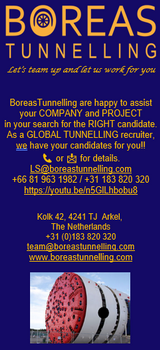Australia: Consortium announced as preferred proponent for the largest infrastructure project in South Australian history
South Australia's government announces the consortium of John Holland, Bouygues Construction Australia, Jacobs, Arcadis and Ventia as preferred proponent for the River Torrens to Darlington Project in South Australia.
According to government information, the design of the T2D Project consists of two tunnels joined by an open motorway. The Southern Tunnels will connect Darlington to Anzac Highway, while the Northern Tunnels will connect to Torrensville (River Torrens).
- Run between the open motorway at Darlington to just south of Anzac Highway in Glandore and provide key connectivity to Anzac Highway
- Includes about 4km of twin three-lane tunnels
- Connecting to key routes such as Richmond Road and James Congdon Drive, it will provide critical east-west connectivity and links to key destinations such as the airport
- Just over 2.5km in length
- Run between James Congdon Drive and the existing open motorway south of Grange Road
- Includes about 2.2km of twin three-lane tunnels
When complete, more than 50% of the T2D Project will be tunnels.
Press release published on Sunday, 11 August 2024.
Getting the North-South Corridor done
The largest and most complex infrastructure project in South Australian history has reached a major milestone, with a preferred alliance partner being selected for the nation-shaping project.
The project will be completed by deadline, but it’s likely South Australians will be able to enjoy the full benefits of the T2D Project even sooner than expected – with three Tunnel Boring Machines to be operating at the same time, instead of the expected two.
Once finished, the T2D project will allow motorists to avoid 21 existing sets of traffic lights between the River Torrens and Darlington and will complete the non-stop 78 kilometre North-South Corridor between Gawler and Old Noarlunga.
Following an exhaustive procurement process which commenced in January 2023, the consortium, comprising John Holland, Bouygues Construction, Arcadis Australia, Jacobs and Ventia, has been selected as the preferred alliance partner to deliver South Australia’s biggest-ever infrastructure project.
The successful consortium has confirmed it can deliver the T2D Project on budget, delivering significant travel, economic and community benefits for South Australians.
These companies individually have an extensive track record of successfully delivering major tunnelling and infrastructure projects around the country and internationally.
This includes WestConnex, Sydney Metro and Southwest Tunnel and Station Excavation and Sydney Airport Rail Link, as well as the Trunk Road T2 Project in Hong Kong and High Speed 2 Link in the United Kingdom.
The successful consortium was announced on Sunday, 11 August 2024 – in the third quarter of 2024 as promised – providing further certainty that the T2D project is on schedule.
The consortium’s tender detailed a plan to procure three Tunnel Boring Machines (TBMs), instead of the two previously anticipated – which will mean both north and south tunnels can be constructed concurrently.
The three TBMs that will be used to excavate the T2D tunnels will be purpose-built for the local conditions they will encounter on this project.
The additional TBM gives us a reasonable expectation that this state-shaping project can not only be completed by the stated 2031 deadline – but even earlier.
The successful consortium’s design delivers the key features of the December 2022 Reference Design release, while providing further traffic and community benefits.
Enhancements from the 2022 Reference Design proposed by the successful consortium include:
- A connection free from traffic lights between the motorway and James Congdon Drive, providing seamless access to and from the CBD;
- Innovative tunnel portal arrangements that enable improved and lowered motorway sections with faster construction times and reduced costs;
- More trees planted to help green the corridor;
- Improved tunnel design and shorter cut and cover tunnel sections, which will reduce energy use and costs, and minimise surface impacts to communities next to the T2D motorway;
- Innovation for the construction of tunnel cross passages, and other systems elements of the tunnels; and
- Improved experience for active travel users with universally accessible paths, shared-use paths and active travel corridors, with regular safe east-west connections.
The T2D project will support approximately 5,500 jobs per year during main construction, with 90 per cent of labour hours to be undertaken by South Australians.
It will also deliver unprecedented opportunities for South Australian businesses, with more than 300 local businesses already registering their interest in being involved as a sub-contractor on the T2D project through the Industry Capability Network.
The consortium has committed to a minimum of 6 per cent Indigenous employment on the project, as well as more than 600 jobs for apprentices and trainees, and opportunities for more than 220 long-term unemployed people.
Main construction works are proposed to start in 2025, with tunnel boring machine works for the southern tunnels planned to begin in the second half of 2026.
source: South Australian Government T2D Information.
cover tunnel photo by: Matt Brown from London, England / CC BY
Copyright 2019-2024 TunnelContact.com








Will the project management consider Robbins or other TBM brands for choosing the TBM for those tunnels? Or will they just go for "your regular sir" way and pass any extra costs to the Australian taxpayers?